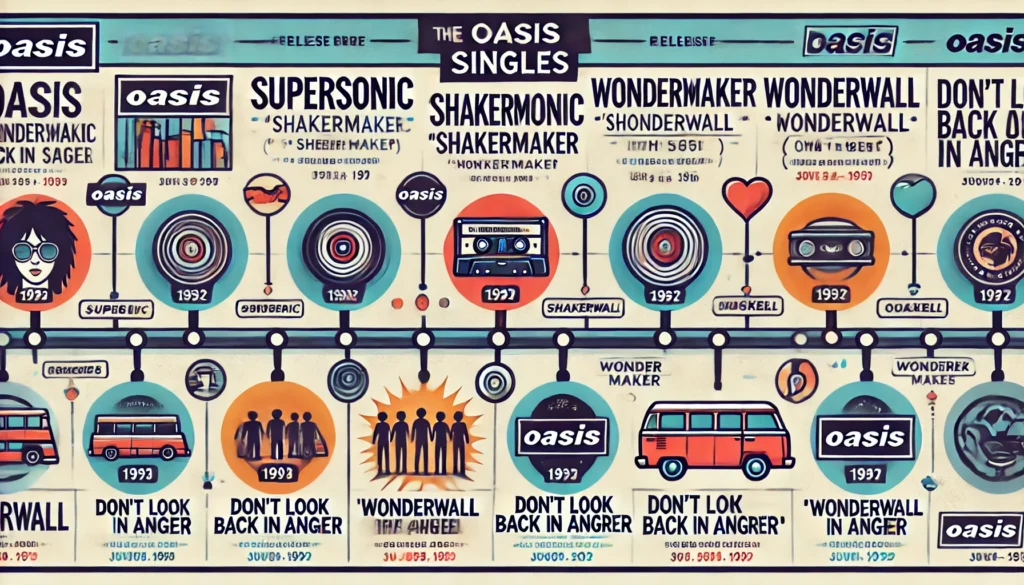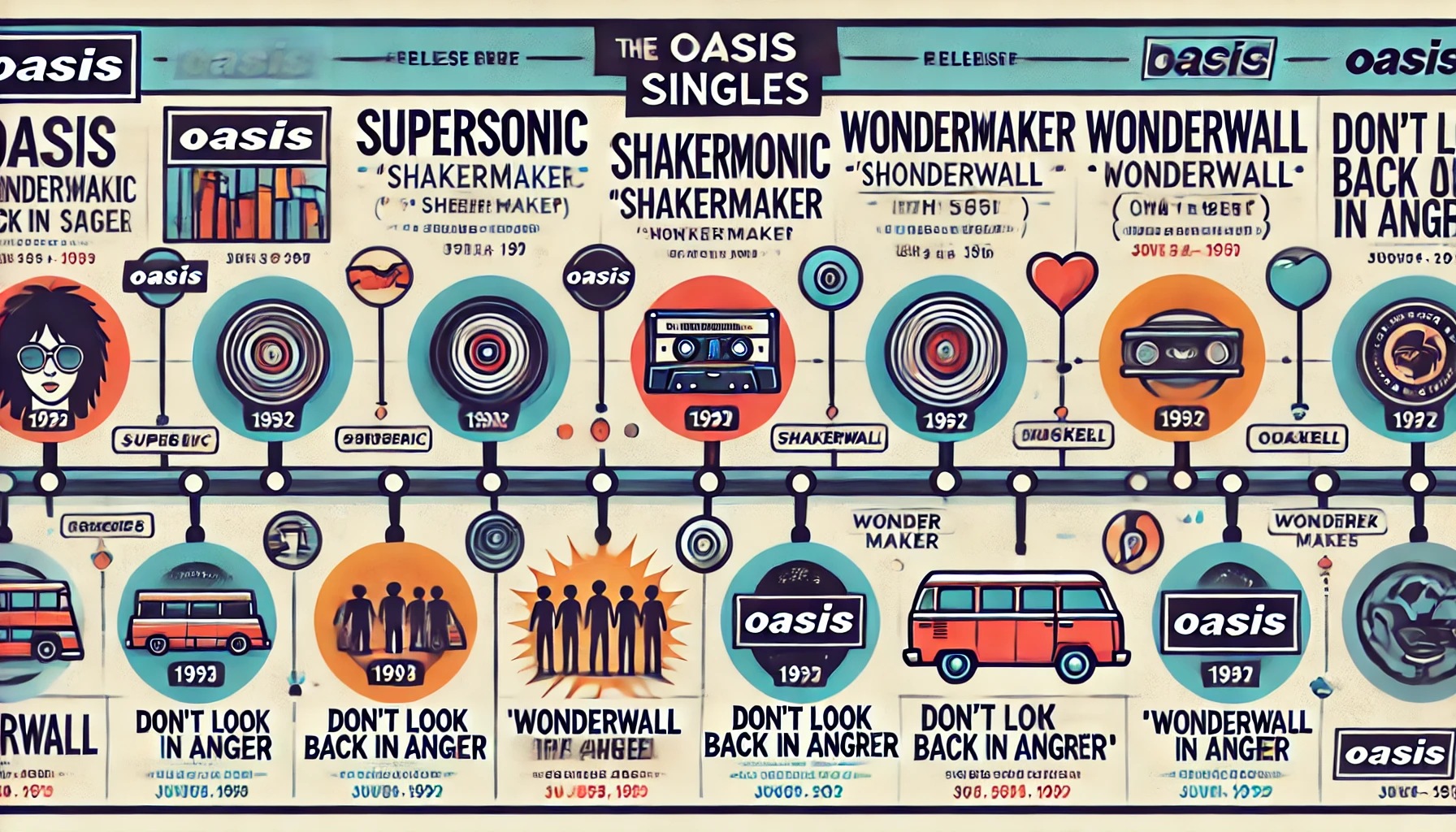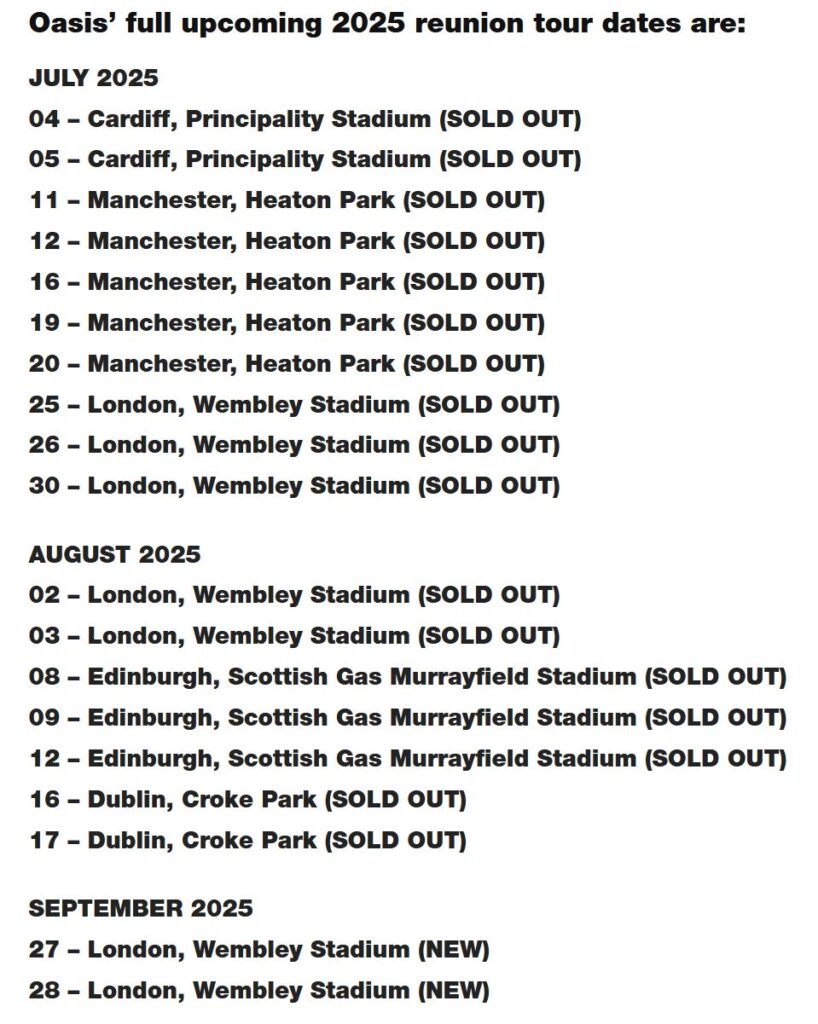If you’re looking for Oasis singles in order of release, you’ve got a legendary list ahead. Start with “Supersonic” on April 11, 1994, followed by “Shakermaker” in June and iconic tracks like “Live Forever” and “Cigarettes & Alcohol” later that year. In 1995, they hit big with “Some Might Say” and “Wonderwall,” and by 1996, “Don’t Look Back in Anger” became a classic. Their last UK Number 1 was “The Importance of Being Idle” in 2005. Each single contributed to their iconic status, and there’s much more you’ll uncover about them.

Overview of Oasis Singles in Order of Release
Since their debut in the mid-1990s, Oasis has become synonymous with Britpop and rock music, releasing a total of 31 singles that have left a lasting mark on the charts.
You’ll quickly notice how their initial single, “Supersonic,” launched them into the public eye, setting the stage for a career filled with chart-topping hits. Their primary UK Number 1 single, “Some Might Say,” followed in May 1995, showcasing their ability to connect with audiences.
Oasis didn’t just stop at one hit; “Wonderwall,” released in October 1995, remains a timeless classic that many still sing today.
Over the next decade, the band achieved eight UK Number 1 singles, solidifying their status as rock legends. Songs like “D’You Know What I Mean?” and “All Around the World” highlighted their extensive chart presence, with “D’You Know What I Mean?” impressively peaking at Number 1 for 25 weeks.
Each single you investigate reflects the band’s evolution, merging catchy melodies with thought-provoking lyrics. Their albums, particularly Definitely Maybe, played a crucial role in establishing their sound and cultural impact.
Oasis not only left their mark on the charts but also reshaped the terrain of rock music for generations to come.
Early Singles Released
Kicking off their career with a series of impactful releases, Oasis quickly captured the attention of the UK music scene. Their debut single, “Supersonic,” dropped on April 11, 1994, and although it peaked at #31 in the UK charts, it laid the groundwork for their burgeoning reputation.
The band followed up with “Shakermaker” on June 27, 1994, which improved their standing, reaching #11 on the charts.
As you explore their early singles, you’ll notice a significant shift with “Live Forever,” released on August 8, 1994. This track marked a turning point, becoming Oasis’s initial Top 10 hit, peaking at #10 and showcasing their lyrical depth and powerful sound.
Then came “Cigarettes & Alcohol” on September 14, 1994, which climbed even higher, hitting #7 in the UK charts.
Finally, their fifth single, “Whatever,” released on November 21, 1994, achieved notable success by reaching #3. Oasis’s early singles had a lasting impact on the Britpop movement, influencing many bands that followed.
Each of these early singles not only solidified Oasis’s place in the music scene but also set the stage for their legendary status in rock history.
Breakthrough Hits
Oasis didn’t just make waves with their initial singles; they quickly changed those early successes into breakthrough hits that defined the Britpop period. “Some Might Say,” released in May 1995, became their foremost #1 single, drawing the interest of a wider audience and showcasing their growing popularity. This track opened the floodgates for even more iconic singles.
Following this, “Wonderwall,” released on October 30, 1995, solidified their status as a Britpop powerhouse. It reached #8 in the UK charts and remains one of the band’s most recognizable songs, capturing the essence of the 90s.
“Live Forever,” released earlier in August 1994, was another crucial moment as it marked their initial Top 10 hit, reaching #10 and further elevating their presence.
The release of “D’You Know What I Mean?” on July 7, 1997, was a proof of their peak, debuting at #1 and enjoying an impressive 25-week chart run. Each of these breakthrough singles not only showcased Oasis’s developing sound but also cemented their legacy in rock music, clearing the path for future generations. Notably, the band’s reunion comes as they celebrate the 30th anniversary of their debut album, which further highlights their lasting impact on the music scene.
Notable Chart Performances
The chart performances of Oasis singles highlight their extraordinary voyage through the music scene. You can see their exceptional impact on the UK singles charts, beginning with their initial Number 1 hit, “Some Might Say,” in May 1995. This milestone marked the start of a string of commercial successes, with many of their tracks consistently reaching impressive chart positions.
One of Oasis’s most iconic songs, “Wonderwall,” peaked at Number 2, showcasing the band’s ability to create timeless anthems that connect with fans.
Their last UK Number 1 single, “The Importance of Being Idle,” came in April 2005, closing a significant chapter in their chart history. Remarkably, “D’You Know What I Mean?” spent an astounding 25 weeks at Number 1, solidifying their dominance during the height of their popularity. Additionally, the band’s legacy continues to be celebrated through exclusive content that captures their influence on the music industry.
Later Singles and Evolution
As the years went by, Oasis demonstrated their ability to evolve while still capturing the essence of what made them iconic. Their later releases continued to reflect their growth as musicians, proving they weren’t just a flash in the pan.
Tracks like “The Importance of Being Idle” and “Lyla,” both released in 2005, reached number one in the UK charts, showcasing their extraordinary chart success during the mid-2000s.
“The Shock of the Lightning,” released in 2008, further solidified their enduring popularity, climbing to number one and remaining on the charts for an impressive 33 weeks. This continued success highlighted the band’s knack for crafting songs that connected with both new and long-time fans.
Oasis’s evolution didn’t mean straying too far from their roots; instead, they blended their signature sound with fresh influences, keeping their music relevant.
Their later releases not only achieved notable chart positions but also reinforced their status as one of rock’s most influential acts.
Altogether, Oasis’s path through their singles reflects a vibrant mix of consistency and innovation, ensuring their legacy endures in the annals of music history.
Promotional Singles
Promotional singles played a crucial role in Oasis’s strategy to engage audiences and build anticipation for their albums. These releases often served as a bridge between studio albums, generating buzz and capturing media attention.
One notable promotional single, “Whatever,” was released in November 1994. This non-album track showcased the band’s signature sound and quickly became popular, highlighting their unique style.
Another iconic song, “Champagne Supernova,” while not released as a traditional single, was heavily promoted from the album “(What’s the Story) Morning Glory?” Its popularity skyrocketed, making it one of Oasis’s most recognized tracks.
The promotional approach for songs like “D’You Know What I Mean?” also involved significant media campaigns and live performances, further attracting listeners.
In 2005, “The Importance of Being Idle” emerged as a promotional single that achieved impressive commercial success, reaching number one in the UK charts.
Legacy and Impact
Oasis has undeniably carved out a significant place in rock history, leaving behind a legacy that continues to echo with fans and musicians alike. With 31 singles, including multiple #1 hits, Oasis set the standard for Britpop and reshaped the music terrain. Their single “Wonderwall” remains the most-streamed song of all time from the band, showcasing its enduring impact and cultural significance.
The band’s second album, (What’s the Story) Morning Glory?, produced timeless anthems that not only topped charts but also became staples in rock music. The album’s success solidified their status as one of the greatest acts in British rock, further enhancing their legacy.
Even years after their split, the demand for reunion tickets broke records, proving Oasis’s lasting relevance in the industry. The recent 30th anniversary re-release of “Definitely Maybe” celebrated the album’s legacy, reigniting interest in their work and returning it to number one on the Official Albums Chart.
This resurgence highlights how their singles and albums continue to connect with new generations, ensuring that Oasis’s impact on music will be felt for years to come. Their legacy is a tribute to the power of their artistry.
List of Oasis singles in order of release
| Single Title | Release Date | First Live Performance |
|---|---|---|
| Supersonic | April 11, 1994 | April 18, 1994 (Glasgow, Scotland) |
| Shakermaker | June 13, 1994 | May 31, 1994 (Sheffield, England) |
| Live Forever | August 8, 1994 | April 17, 1994 (Newcastle, England) |
| Cigarettes & Alcohol | October 10, 1994 | May 1994 (Cambridge, England) |
| Whatever | December 18, 1994 | December 1994 (London, England) |
| Some Might Say | April 24, 1995 | April 22, 1995 (Paris, France) |
| Roll With It | August 14, 1995 | July 22, 1995 (Tokyo, Japan) |
| Wonderwall | October 30, 1995 | August 15, 1995 (Chicago, USA) |
| Don’t Look Back in Anger | February 19, 1996 | March 3, 1996 (Manchester, England) |
| Champagne Supernova | May 13, 1996 | April 27, 1996 (Los Angeles, USA) |





